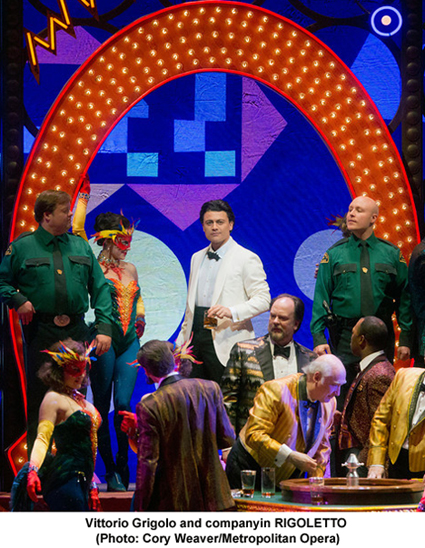 In the February 2013 issue of Opera News, director Michael Mayer offered a lengthy explanation of why he chose not to set his new production of Verdi's Rigoletto for the Metropolitan Opera in the original milieu of 16th-century Mantua but, rather, has updated the action to Las Vegas in 1960. Mayer makes the case that the licentious court of the Duke of Mantua has strong parallels in the amoral world of Vegas during the "Rat Pack" years, but he fails to mention that the music Verdi composed for this story -- music that is sometimes chillingly dark and powerful, but always exhibits the formality that was part and parcel of Italian opera in the Romantic period -- is thoroughly inapposite to the new setting.
In the February 2013 issue of Opera News, director Michael Mayer offered a lengthy explanation of why he chose not to set his new production of Verdi's Rigoletto for the Metropolitan Opera in the original milieu of 16th-century Mantua but, rather, has updated the action to Las Vegas in 1960. Mayer makes the case that the licentious court of the Duke of Mantua has strong parallels in the amoral world of Vegas during the "Rat Pack" years, but he fails to mention that the music Verdi composed for this story -- music that is sometimes chillingly dark and powerful, but always exhibits the formality that was part and parcel of Italian opera in the Romantic period -- is thoroughly inapposite to the new setting.
Based on a play by Victor Hugo (who also gave us Les Miserables, The Hunchback of Notre Dame, etc.), Rigoletto is a masterpiece not only because of Verdi's immortal score but also thanks in large degree to Francesco Maria Piave's libretto, a gripping tale without an ounce of fat on it. The three main characters are the aforementioned Duke of Mantua, a Don Juan type whose attitude is that he can get away with all sorts of heinous behavior simply because he's rich and powerful; the hunchback jester Rigoletto, who is despised by the courtiers even as he entertains them with his biting wit; and Rigoletto's innocent, virginal, young daughter Gilda, who has the misfortune to become the Duke's latest conquest.
In Mayer's vision, the Duke is a Vegas crooner of the Sinatra variety, although nowhere near as famous, and Rigoletto is what you might call an insult comedian (think Don Rickles). The total disconnect between the music and the action is obvious as soon as the lights come up on the first scene of Act 1, which now unfolds in "The Duke's casino." What we see is the crowded gaming floor of the casino, awash in multi-colored neon and the blinking lights of slot machines, but what we hear is an elegant, bouncy little tune that sounds like it comes from -- well, from a mid 19th-century Italian opera. The effect is jarring, and not in a good way, as if someone were to revive H.M.S. Pinafore and set it on a modern-day cruise ship headed for Miami without changing the music, the lyrics, the arrangements, the orchestrations, or even the character names. In short, it just doesn't work.
On top of the flagrant musical anachronism(s), it turns out that, while many of the characters and plot elements of the opera as written do indeed jibe with the new setting and time period, some decidedly do not. The idea that Rigoletto has a pure, trusting devoutly religious daughter whom he's sheltering from the evil world at large makes complete sense if he's hiding her away in a house on a deserted street in an Italian city in the 1500s, as opposed to the risible thought that such a naive young woman might be living in the heart of Sin City in 1960. I regret to report that the Met's supertitles actually mis-translate some of the libretto to make it try to fit the new milieu; we get phrases such as "You lousy bums!" and "Take him for a ride." But even this is done inconsistently. For example: Monterone, the courtier who curses Rigoletto for making fun of his daughter's violation by the Duke, is for some reason depicted here as "an Arab tycoon" whom the others sometimes refer to as "the Sheik" -- yet he's still called "Monterone," a name as unmistakably Italian as my grandma's.
While all this nonsense and much more was happening at a recent performance, the musical quotient of the opera was being treated with the respect it so richly deserves. Conductor Marco Armiliato and the Met orchestra gave a superb reading of the score. Tenor Vittorio Grigolo sang like a god as the Duke, and he's so strong as an actor that the Sinatra-esque reconception of the role worked best of all the leading characters. Soprano Lisette Oropesa failed to make too-good-to-be-true Gilda credible in her new surroundings -- surely, no one could -- but she sang with an effulgent beauty that happily distracted attention from the weirdness of the production. George Gagnidze gave perhaps the best sung performance of the title role that I've ever heard, but he didn't convincingly communicate Rigoletto's anguish at the horrific turns of the plot.
Though the design elements of this misconceived Rigoletto are wildly at odds with the original story, Christine Jones (sets), Susan Hilferty (costumes), and Kevin Adams (lighting) offer designs that are very impressive on their own terms and would have been terrific for an opera believably set in Las Vegas in 1960. (I guess it would have to be a new work. Imagine that!) I should note that this Rigoletto received a number of highly favorable reviews, and in fact, the friend with whom I attended said he had no problem at all with the update. But the production is vexing to those of us who are proud to be labeled "purists" if purism is defined as the insistence than an opera performance be dramatically as well as musically viable.
